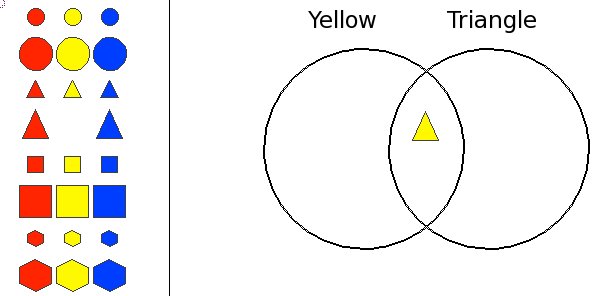Mentor: In our last discussion, we talked a lot about sets. Can you explain what a set is?
Student 1: Yes, a set is a group of objects that have similarities such as color, size or shape. Each individual object is called an element.
Mentor: If I have two sets of shapes, is it possible for the sets to have elements in common? Can an element be in both sets?
Student 2: Yes, because sets can be classified by different things, an element can be in one set because of its color, and in another because of its size.
Mentor: Great! So, elements can be part of two sets at once. I'm going to draw a picture to represent
that, and you can help me put some elements in the correct place.

Mentor: I put the triangle in the place where these two circles overlap. Why do you think that I did that?
Student 1: Well, it's a triangle but it's also yellow, so it is a part of both sets and should go in both circles. The way you drew it, it's clear that the overlap area represents belonging in both circles.
Mentor: So what should we call those circles?
Student 2: Each circle is a set.
Mentor: Right! Can anyone think of another shape that I could put in this diagram? What about a shape that is yellow, but that isn't a triangle?
Student 1: You could put the small yellow circle in the yellow circle, but not in the triangle circle, because it's not a three sided figure.
Mentor: Exactly! What we are making is called a Venn Diagram. Sometimes we use Venn diagrams with two circles, like the one we have drawn here, and sometimes it may be best to use one with more than two circles! Let's try to create a Venn diagram with three circles.
Student 2: To create a Venn diagram with three circles you will you have to find three categories or descriptions that could work together to create sets.
Mentor: The important thing to realize is that the categories have to have an intersection. What do you think this means?
Student 1: Does it mean that they have to have something in common?
Mentor: Sort of. It just means that it's possible for all categories to happen at once. For instance, the categories green, small, and striped can all describe the same object. But what if I said I had a big, small, blue object?
Student 2: I wouldn't believe you! It can't be both big and small.
Mentor: Exactly! Can you think of any examples of three categories that will work for a three circle Venn diagram?
Student 1: In a three circle Venn diagram we could use the categories circle, red, and big.
Mentor: Correct! What is a shape that would be in the area where all three circles overlap?
Student 2: The big red circle would fit in all three. While the big blue circle and big yellow circle would only fit in the intersection of big and circle.
Student 1: The small red circle would go in the intersection for red and circle, while the small yellow and small blue circle would only go in the circle set. The big red triangle, square, and hexagon would go in the area for big red shapes. The other red shapes would go in the red set, and the other big shapes would go in the big set.
Mentor: You both are right, great job!